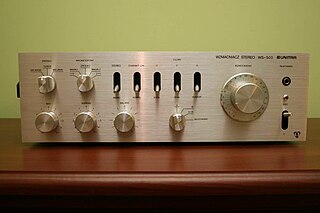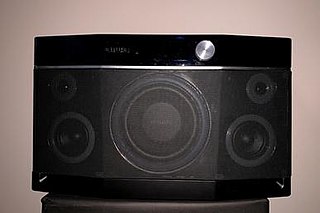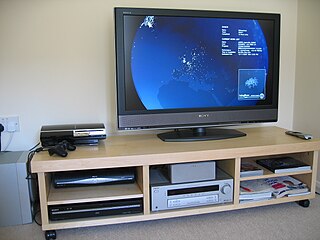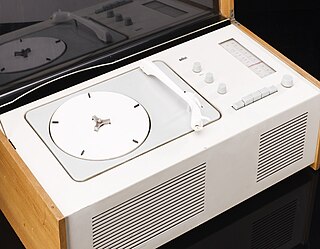
The Compact Cassette or Musicassette (MC), also commonly called the tape cassette, cassette tape, audio cassette, or simply tape or cassette, is an analog magnetic tape recording format for audio recording and playback. It was developed by the Dutch company Royal Philips in Hasselt, Belgium, by Lou Ottens and his team. It was introduced in September 1963. Compact Cassettes come in two forms, either already containing content as a prerecorded cassette (Musicassette), or as a fully recordable "blank" cassette. Both forms have two sides and are reversible by the user.

Vehicle audio is equipment installed in a car or other vehicle to provide in-car entertainment and information for the vehicle occupants. Until the 1950s it consisted of a simple AM radio. Additions since then have included FM radio (1952), 8-track tape players, cassette players, record players, CD players (1984), DVD players, Blu-ray players, navigation systems, Bluetooth telephone integration, and smartphone controllers like CarPlay and Android Auto. Once controlled from the dashboard with a few buttons, they can now be controlled by steering wheel controls and voice commands.

An audio power amplifier is an electronic amplifier that amplifies low-power electronic audio signals such as the signal from radio receiver or electric guitar pickup to a level that is high enough for driving loudspeakers or headphones. Audio power amplifiers are found in all manner of sound systems including sound reinforcement, public address and home audio systems and musical instrument amplifiers like guitar amplifiers. It is the final electronic stage in a typical audio playback chain before the signal is sent to the loudspeakers.

The 8-track tape is a magnetic-tape sound recording technology that was popular from the mid-1960s to the early 1980s, when the Compact Cassette tape, which predated 8-track, surpassed it in popularity for pre-recorded music. The format is obsolete and was relatively unknown outside the United States, the United Kingdom, Canada, New Zealand, Australia, Mexico, Spain, France, Germany, Italy, Sweden and Japan. The main advantage of the 8-track tape cartridge is that it does not have to be "flipped over" to play the alternative set of tracks.

A CD player is an electronic device that plays audio compact discs, which are a digital optical disc data storage format. CD players were first sold to consumers in 1982. CDs typically contain recordings of audio material such as music or audiobooks. CD players may be part of home stereo systems, car audio systems, personal computers, or portable CD players such as CD boomboxes. Most CD players produce an output signal via a headphone jack or RCA jacks. To use a CD player in a home stereo system, the user connects an RCA cable from the RCA jacks to a hi-fi and loudspeakers for listening to music. To listen to music using a CD player with a headphone output jack, the user plugs headphones or earphones into the headphone jack.
Radio Data System (RDS) is a communications protocol standard for embedding small amounts of digital information in conventional FM radio broadcasts. RDS standardizes several types of information transmitted, including time, station identification and program information.

A boombox is a transistorized portable music player featuring one or two cassette tape recorder/players and AM/FM radio, generally with a carrying handle. Beginning in the mid 1980s, a CD player was often included. Sound is delivered through an amplifier and two or more integrated loudspeakers. A boombox is a device typically capable of receiving radio stations and playing recorded music. Many models are also capable of recording onto cassette tapes from radio and other sources. In the 1990s, some boomboxes were available with minidisc recorders and players. Designed for portability, boomboxes can be powered by batteries as well as by line current. The boombox was introduced to the American market during the late 1970s. The desire for louder and heavier bass led to bigger and heavier boxes; by the 1980s, some boomboxes had reached the size of a suitcase. Some larger boomboxes even contained vertically mounted record turntables. Most boomboxes were battery-operated, leading to extremely heavy, bulky boxes.

Aiwa (アイワ) is a consumer electronics brand owned and used by various companies in different regions of the world. American and other regions are owned by Chicago-based Aiwa Corporation. Towada Audio based in Tokyo owns rights in Japan and elsewhere and has been manufacturing Aiwa-branded products since 2017. In Mexico and other countries in Latin America, rights are owned by Audio Mobile Americas, S.A.

Monaural or monophonic sound reproduction is sound intended to be heard as if it were emanating from one position. This contrasts with stereophonic sound or stereo, which uses two separate audio channels to reproduce sound from two microphones on the right and left side, which is reproduced with two separate loudspeakers to give a sense of the direction of sound sources. In mono, only one loudspeaker is necessary, but, when played through multiple loudspeakers or headphones, identical signals are fed to each speaker, resulting in the perception of one-channel sound "imaging" in one sonic space between the speakers. Monaural recordings, like stereo ones, typically use multiple microphones fed into multiple channels on a recording console, but each channel is "panned" to the center. In the final stage, the various center-panned signal paths are usually mixed down to two identical tracks, which, because they are identical, are perceived upon playback as representing a single unified signal at a single place in the soundstage. In some cases, multitrack sources are mixed to a one-track tape, thus becoming one signal. In the mastering stage, particularly in the days of mono records, the one- or two-track mono master tape was then transferred to a one-track lathe intended to be used in the pressing of a monophonic record. Today, however, monaural recordings are usually mastered to be played on stereo and multi-track formats, yet retain their center-panned mono soundstage characteristics.

In radio communications, a radio receiver, also known as a receiver, a wireless or simply a radio, is an electronic device that receives radio waves and converts the information carried by them to a usable form. It is used with an antenna. The antenna intercepts radio waves and converts them to tiny alternating currents which are applied to the receiver, and the receiver extracts the desired information. The receiver uses electronic filters to separate the desired radio frequency signal from all the other signals picked up by the antenna, an electronic amplifier to increase the power of the signal for further processing, and finally recovers the desired information through demodulation.

A music centre, also known as a music complex, is a type of integrated audio system for home use, used to play from a variety of media. The term is usually used for lower end or sub-high fidelity equipment. In American English, these systems are typically referred to as "compact stereos", "shelf stereos" or simply "stereos." The term itself has been in use since the 1970s, though in more recent times the terms mini, micro or mini hi-fi, or integrated hi-fi have been preferred. The distinguishing feature compared to high-end equipment is that there is usually only one main unit, with maybe a pair of detachable or separate loudspeakers, though some equipment also has these built into the main unit.

An entertainment center, also known as an entertainment complex, is a piece of furniture designed to house consumer electronic appliances and components, such as televisions.
Philco was a pioneer in battery, radio, and television production. In 1961 the company was purchased by Ford and was known as Philco-Ford from 1966. Ford sold the company to GTE in 1974, and it was purchased by Philips in 1981. In North America, the Philco brand is currently owned by Philips. In other markets, the Philco International brand is owned by Electrolux.

An audio/video receiver (AVR) is a consumer electronics component used in a home theater. Its purpose is to receive audio and video signals from a number of sources, and to process them and provide power amplifiers to drive loudspeakers and route the video to displays such as a television, monitor or video projector. Inputs may come from a satellite receiver, radio, DVD players, Blu-ray Disc players, VCRs or video game consoles, among others. The AVR source selection and settings such as volume, are typically set by a remote controller.

An antique radio is a radio receiving set that is collectible because of its age and rarity.
Luxman is a brand name of Japanese Luxman Corporation (ラックスマン株式会社), a company that manufactures luxury audio components. Luxman produces a variety of high-end audio products which include turntables, amplifiers, receivers, tape decks, CD players and speakers

In British English, a radiogram is a piece of furniture that combined a radio and record player. The word radiogram is a portmanteau of radio and gramophone. The corresponding term in American English is console.

Realistic is a brand produced by RadioShack, a division of Tandy Corporation, to market audio and video products for home use. The brand name was phased out in the mid 1990s and discontinued in 2000, then returned briefly in 2016.
Hacker Radio Limited manufactured domestic radio and audio equipment. The company was formed in Maidenhead by brothers Ron and Arthur Hacker in 1959, and traded successfully until 1977. Financial difficulties resulted in the company being sold and relaunched with the name Hacker Sound which closed in 1979.

A shortwave radio receiver is a radio receiver that can receive one or more shortwave bands, between 1.6 and 30 MHz. A shortwave radio receiver often receives other broadcast bands, such as FM radio, Longwave and Mediumwave. Shortwave radio receivers are often used by dedicated hobbyists called shortwave listeners.
















